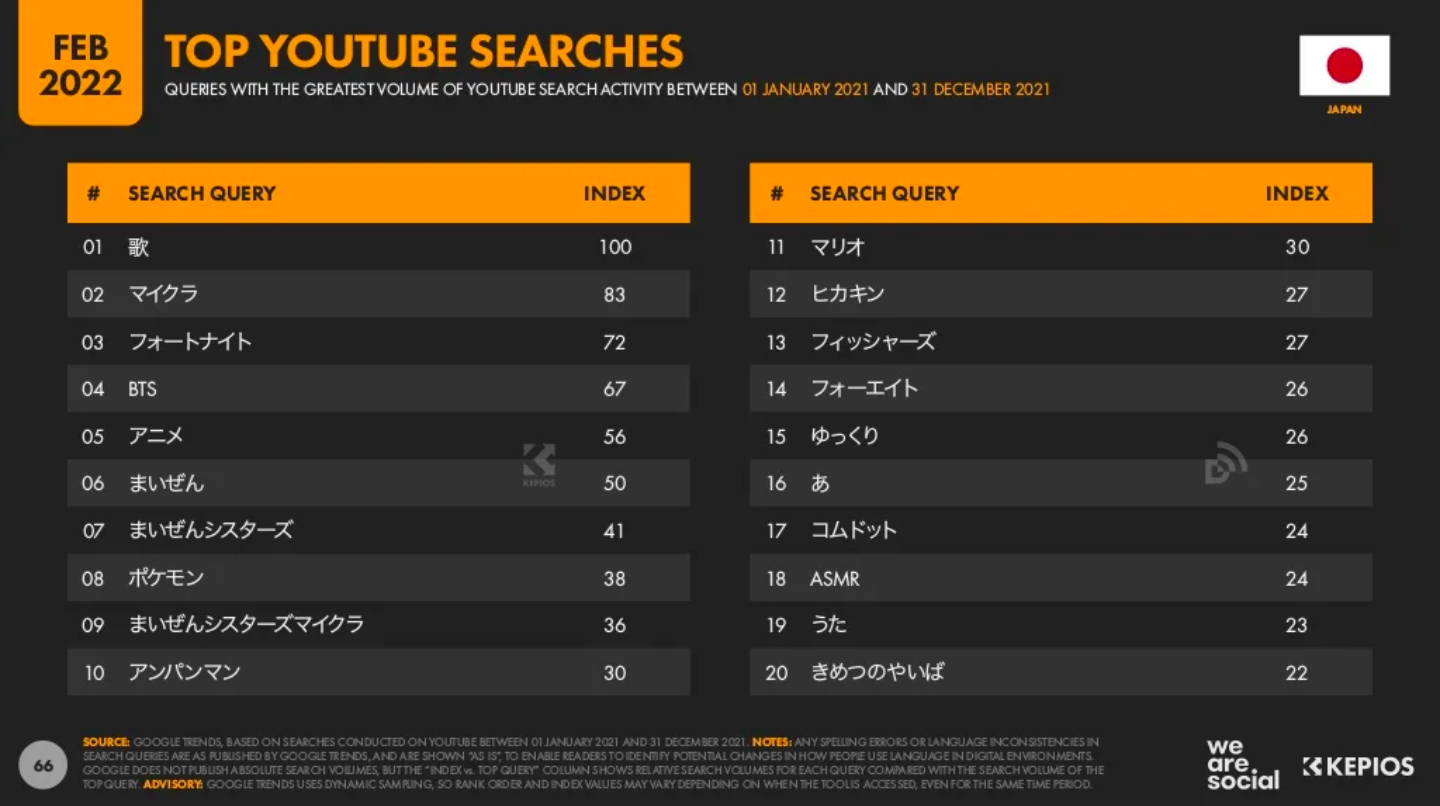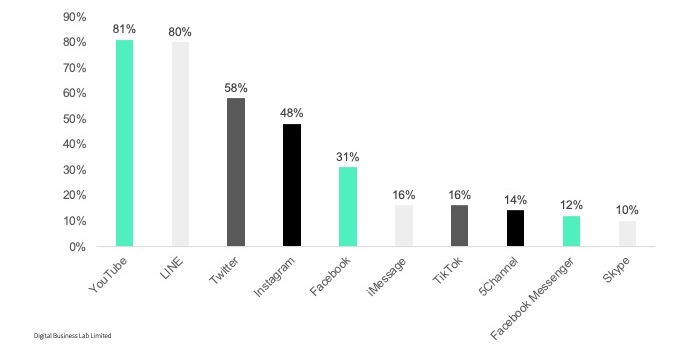Welcome to article 2/3, which examines the usage & penetration of social media in Japan. This article emphasizes how critical it is for brands to comprehend how Japanese consumers use and rely on social media platforms. In a market with its own distinctive social media ecosystem, it’s crucial to remind yourself that your audience and what makes them tick are the core to the success of your social media strategy in a market with many local competitors. Only a brand with a thorough awareness of the market and its target audiences can succeed.
Social Media User Penetration in Japan
- Japan had 102 million internet users in January 2022, equivalent to 81% of the total population; this was an increase of 4.4 million (+5%) between 2021 and 2022.
- According to DataReportal, as of February 2022, YouTube ranked Japan’s most popular social media platform with an 81% penetration rate. Followed by LINE (80%) and Twitter (58%).
- Instagram, Facebook and TikTok took 4th, 5th and 6th place.
- Japan’s population of social media users is expected to reach 110.7 million by 2025.
- The average time Japanese users spend on smartphones each day is 4.5 hours.
2022 Top 10 Most-Used Social Media Platforms in Japan (Users aged 16 to 64)
Japanese Social Media Platform Usage
Top 5 Main Reasons for Japanese Using Social Media
- Filling Spare Time (26%)
- Seeing What’s Being Talk About (25%)
- Keeping In Touch With Friends & Family (24%)
- Reading News Stories (22%)
- Finding Content (22%)
1. YouTube: The clear winner in Japan
- According to DataReportal, the potential reach of ads on YouTube is 102 million (81% of the total population).
- The channel shows a +9% (+8.2 million) year-on-year increase in YouTube ad reach.
- Its popularity could be attributed to a cultural shift from blogging to vlogging.
- According to Statista, YouTube was used by 98% of people aged 20 to 29 years old in Japan in 2021, making it highly influential in terms of video views.
- So-called “VTubers,” or virtual YouTubers made using motion capture technology, are a growing craze in Japan. Kizuna Ai, who made her YouTube debut in 2016, is one of the most well-known virtual YouTubers credited with coining the term “VTuber”. Other famous VTubers include Kaguya Luna and Shirakami Fubuki.
- The Japanese mainly use YouTube to kill time, gain updates on topics of interest, and discover something new (User motivation of Youtube, Trenders).

💡 Takeaways: In Japan, YouTube is the to-go platform to reach and communicate with the Generation Z audience. In addition, the large audience for Vtubers has similarly created a desire for brands to reach those audiences. Brands are recommended to connect with the Japanese audience and show they understand their audiences through anime content, Vtubers or branded characters.
葛葉 Kuzuha – one of the most popular VTuber in Japan among Gen Z, collaborates with a Japanese skincare brand.
2. LINE: The domestic messaging app
- The second most popular app in Japan is the messaging service LINE.
- It is known locally as a “super app” that “does everything” and has been compared to WeChat in China and KakaoTalk in South Korea.
- LINE has 89 million monthly active users in Japan (71% of the total population), with 56% female and 44% male users.
- LINE is the most used text app in Japan and is also popular in Thailand, Taiwan and Indonesia.
- In Japan, LINE has been used for peer learning, whereas in Thailand, it has been used by luxury brands to “organize inventory” and “manage customer relationships”.
- There was a surge in the number of users in 2020 credits to its coronavirus support features and track-and-trace service offered within the app. For instance, 19 Japanese prefectures took LINE to offer “coronavirus consultations” in 2020.
- LINE stands apart from other IM apps thanks to its well-known stickers. As you might expect in a country that enjoys anime and emoticons, the app skyrocketed in popularity.
- Additionally, creators can share their original stickers for free or sell them for LINE coins, which users of the app use to pay for stickers and themes.

LINE Timeline ads can be shown to all users regardless of their official LINE account’s blocked status.
💡 Takeaways: LINE’s messaging and video chat features are excellent, but that isn’t the only thing the app excels at. LINE has many other features that make them worthy of its super app title, such as Timeline, LINE Today, LINE Pay, LINE Games, LINE TV, LINE Mango, LINE shopping, etc. Brands are recommended to leverage the platforms’ wide variety of unique ads placement to reach their desired audiences in the Japanese market.
3. Twitter: Real-time and spreading power
- Twitter has 59 million monthly active users in Japan (47% of the total population).
- Twitter’s potential ad reach in Japan is 59 million, equivalent to 47% of the total population.
- The micro-blogging platform shows a +1% (+750 thousand) increase in Twitter ad reach year-on-year.
- Regarding global Twitter users, Japan comes second as the leading country after the USA, with 76.9 million users.
- More than 70% of Japanese internet users are anonymous. The often-reserved Japanese can express their genuine ideas on current affairs and popular culture through anonymous Twitter accounts.
- More than in other nations, Twitter is used to discuss products in Japan. Japanese consumers use Twitter as a search engine to see what actual people are saying about products because many websites’ reviews don’t adequately reflect what a thing is genuinely like.
- As a result, Japanese companies successfully promote their products on Twitter.
- Additionally, it’s a tool to engage consumers with brands by learning more about what they desire, think, require, and seek.
\アイスがもらえるキャンペーン開催中/
10/3まで対象の「クランキー ビッグパウチ」を買うと「爽 バニラ」の(お持ち帰り限定)無料券がレシートについてきます(^^)#ローソン #ロッテhttps://t.co/YqPFKVYbpC pic.twitter.com/rA4B7WL6aP— ローソン (@akiko_lawson) September 29, 2022
The Japanese convenient store Lawson frequently communicates its latest offers on Twitter.
💡 Takeaways: Twitter is a precious resource for up-to-the-minute news in Japan. Communities that revolve around a specific subject or subculture also utilize it. It is an effective tool for achieving a particular segment. Brands are recommended to leverage Twitter as a channel to communicate with the Japanese audience as the core of customer service. Japanese audiences expect to get information about special sales, discounts or giveaways from an official Twitter page, be rewarded as loyal customers, receiving access to exclusive news not open to everyone.
4. Instagram: Using stories & reels is key
- Instagram had 46.10 million users in Japan in early 2022.
- According to DataReportal, the potential reach of ads on Instagram is 46 million (81% of the total population).
- The channel shows a +21% (+8.1 million) year-on-year increase in Instagram ad reach.
- Instagram is the most effective medium out of the four for connecting with gen Z consumers, with users aged 18 to 29 spend more than 100 million hours there each month.
- Japan produces 7 million “stories” per day, which is the most in the world and has the second-highest engagement rate.
💡 Takeaway: Brands are recommended to collaborate with Japanese influencers, who are now often active on Instagram. They have built up audiences who interact and engage with them everywhere they appear. Naturally, these influencers leverage platform features well to best suit their purposes, such as Instagram stories with links to product purchase pages. They have been getting creative with Instagram Reels as well. Japanese influencers are known to be shy, but we can see that now they own Reels entirely and are happy to upload short-form video content regularly.
View this post on Instagram
Nakajima Ayano, one of the top fashion influencers in Japan, creatively leveraged dazzling visual effects in her Reels to promote the new launch by Adidas Originals.
5. Facebook: The B2B Marketing Platform
- Meta’s advertising resources showed a potential audience ad reach of 15.6 million on Facebook (12% of the total population).
- Facebook has lesser young users in Japan, yet there is still a valuable group of audiences using this social media channel.
- Facebook has a more significant user base of those over 40, representing the prime decision-making demographic for Japan’s C-suite.
- Since Facebook users must be verified, the platform is mainly used for business networking, unlike Twitter.
- 80% of Japanese enterprises use Facebook—not LinkedIn—for business networking; 57% operate in B2B.
- LinkedIn has a relatively low penetration rate in Japan (3%), where Japanese companies & employees are not active on the platform.
💡 Takeaways: For B2B businesses, Facebook is more effective than LinkedIn for B2B marketing in Japan. Japanese people view LinkedIn as a job search site more than a professional networking platform. Facebook is where business decision-makers live and breathe social in Japan. Facebook has a larger user base of people over 40, the prime age of Japan’s C-suite decision-makers, who are also distinctly more active on Facebook than on LinkedIn.
Aucfan, a Japanese online platform that provides e-commerce price data across American, Chinese, and Japanese markets, establishes a stronger corporate presence on Facebook than on other channels.
In conclusion, Japan has its unique social ecosystem compared to other Asian & western countries. By understanding the social media penetration comprehensively in Japan and how people rely on these social media platforms, brands can create more meaningful connections with customers and better engage with people in Japan.
Explore article 1 of this series:
Explore our other Market Research in Asia:
🇲🇾Malaysia Social Media Insights:
- ① Cultural Social Media Insights in Malaysia [Research]
- ② Social Media Penetration in Malaysia [Research]
- ③ The Popular Social Media trends in Malaysia [Research]
🇹🇭 Thailand Social Media Insights:
- ① Cultural social media insights in Thailand [ Research ]
- ② Social media penetration in Thailand [ Research ]
- ③ The popular Social Media trends in Thailand [ Research ]
🇸🇬 Singapore Social Media Insights:
- ① Cultural social media insights in Singapore [ Research ]
- ② Social media marketing in Singapore [ Research ]
- ③ Online marketing in Singapore [ Research ]
🇻🇳 Vietnam Social Media Insights:
- ① Cultural social media insights in Vietnam [Research]
- ② Social Media Penetration in Vietnam [ Research ]
- ③ The popular Social Media in Vietnam [ Research ]
🇮🇩 Indonesia Social Media Insights:
- ① Cultural social media insights in Indonesia [Research]
- ② Social Media Penetration in Indonesia [Research]



